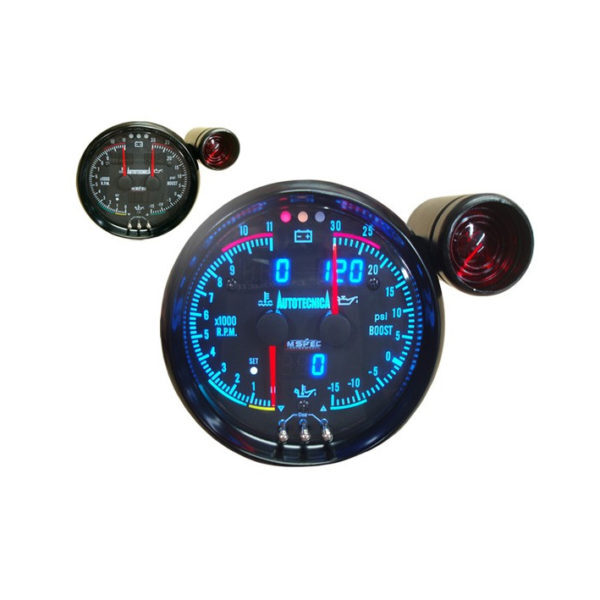Exactly how to Select the Right Tachometer for Your Cars And Truck or Bike
Exactly how to Select the Right Tachometer for Your Cars And Truck or Bike
Blog Article
The Significance of a Tachometer in Keeping An Eye On Engine Speed and Efficiency in Automotive Applications
In the realm of vehicle engineering, the tachometer stands as an essential tool in the chauffeur's collection, supplying a straight home window right into the inner operations of a vehicle's engine. Beyond its feature as a mere gauge of changes per minute (RPM), the tachometer works as a crucial tool for fanatics and professionals alike, providing real-time understandings right into engine performance and health and wellness. Recognizing the significance of this gadget goes past surface-level monitorings, delving into the complex relationship between engine speed, power outcome, and total driving experience. As we explore the diverse duty of the tachometer in auto applications, a deeper gratitude for its influence on vehicle dynamics and effectiveness starts to arise.
Importance of Keeping Track Of Engine RPM
Keeping track of engine RPM, or revolutions per min, is a vital aspect of auto maintenance and performance examination. Engine RPM directly correlates with the speed at which the engine's crankshaft revolves, showing how promptly the engine is running.
Moreover, keeping track of engine RPM is crucial for performance analysis in racing and high-performance lorries. Preserving optimum RPM levels is critical for accomplishing peak power result and acceleration. Racers usually utilize tachometers to guarantee they are operating within the suitable RPM range for maximum efficiency. In summary, keeping an eye on engine RPM is not just important for detecting problems yet also for maximizing engine performance in various vehicle applications.

Advantages of Real-Time Information
In automotive applications, real-time data plays an important function in supplying instantaneous understandings right into the performance and problem of the vehicle. By continuously monitoring different parameters such as engine speed, temperature, gas consumption, and a lot more, real-time information offers many benefits that add to boosted performance and safety and security on the roadway.
Furthermore, real-time information assists in performance optimization by supplying prompt comments on driving behaviors and engine effectiveness. Drivers can readjust their behavior in real-time based on this info to achieve much better fuel economic climate and prolong the life expectancy of their vehicle.

Furthermore, real-time information plays a vital function in modern automobile diagnostics, making it possible for specialists to promptly diagnose and attend to malfunctions. This results in lowered downtime, lower maintenance prices, and ultimately, enhanced general lorry reliability and durability (tachometer). By using the power of real-time data, automobile stakeholders can make enlightened choices that positively affect both the efficiency and long life of the lorry
Impact on Gear Shifts
The tachometer plays a crucial duty in optimizing equipment changes by giving real-time engine rate information to the motorist. When coming close to the redline on the tachometer, it indicates the motorist to upshift to avoid over-revving the engine and triggering potential damage.
Moreover, the tachometer help in attaining smoother gear transitions, particularly in manual transmissions. By checking engine rate, motorists can perform gear changes at the optimum RPM variety, decreasing jerking activities and lessening wear on the transmission components. This accuracy in gear changes not just improves driving comfort yet additionally contributes to fuel efficiency.
Enhancing Gas Effectiveness
Given the critical duty the tachometer plays in enhancing gear changes for performance and engine wellness, it directly adds to making the most of gas effectiveness in auto applications. By supplying real-time feedback on engine rate, the tachometer assists vehicle drivers in preserving one of the most effective RPM array for fuel economic situation. When motorists consistently keep an eye on the tachometer and change their motoring practices as necessary, they can avoid unneeded fuel usage triggered by over-revving or carrying the engine.
In addition, the tachometer helps motorists identify the most fuel-efficient equipment to be in at any provided minute, avoiding the engine from functioning harder than required. This is specifically essential throughout velocity and cruising, where being in the appropriate gear can considerably influence gas efficiency. Furthermore, the tachometer can signal drivers to prospective mechanical problems that can be adversely affecting fuel economic climate, such as a sliding clutch or a clogged up pop over to this site air filter. Finally, the tachometer acts as a beneficial tool in enhancing fuel effectiveness by advertising optimal driving habits and identifying areas for renovation in the automobile's performance.

Maximizing Engine Long Life
The additional resources tachometer's duty in keeping track of engine rate and performance is crucial in making sure the long life of auto engines. Keeping an eye on the tachometer permits drivers to stay within the suggested RPM array for their car, protecting against unnecessary pressure on the engine and extending its life expectancy.

Final Thought
In conclusion, the tachometer plays a critical function in monitoring engine rate and efficiency in vehicle applications. By providing real-time data on RPM, it permits effective equipment shifts, improved Home Page fuel effectiveness, and made the most of engine long life. This tool is vital for keeping ideal engine efficiency and ensuring the general capability of a car.
Report this page